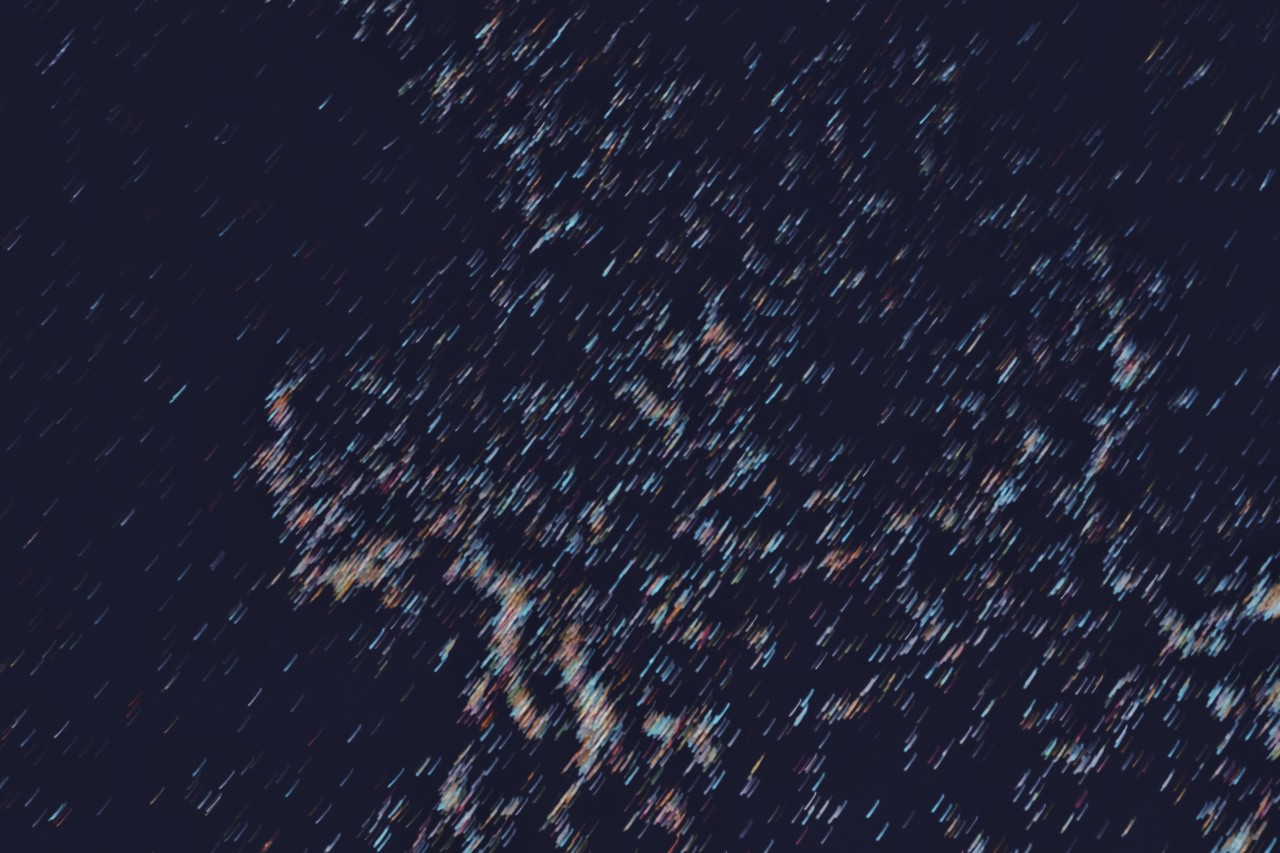

WORDS BY LEWIS GORDON
photographs by miro lovejoy teplitzky
Jeff VanderMeer’s novel Annihilation opens with a biologist entering the mysterious, unpopulated wilderness known as Area X. Nothing seems out of the ordinary at first. The biologist observes the local wildlife: a tiny red-and-green tree frog, a black damselfly, and a pair of otters. Quickly, though, she encounters the incomprehensible: “a low, powerful moaning” audible at dusk; a tower that is not really a tower but a structure that plunges deep underground. There is fungal writing on the walls. It seems to sway “like sea grass in a gentle ocean current.”
Little about Annihilation, and the subsequent Southern Reach series of novels, is straightforward. Area X is an impossible landscape where nature has seemingly gone haywire. The flora and fauna are so abundant and prehistorically super-sized that it seems life itself is occurring at an accelerated rate. Formally, these books operate in multiple modes at once: pulp thriller, nature writing, literary fiction, philosophy. At one point, the biologist, a specialist in “transitional ecosystems,” suffers exposure from a spore. She finds herself compromised by the very environment she is attempting to understand. Wrestling with this shift—of the collapsing boundary between her body and what exists outside of it—VanderMeer summons a distinctly modern gamut of emotions: terror, ecstasy, bewilderment.
In the decade since the series was published in 2014, it has bedded into our own cultural landscape, becoming, in the process, some of the most quietly influential works of fiction from the past decade. These books are taught in university classrooms across the globe, and their unnerving ideas and odd stylistic sensibility have been suffused into many distinct works: video games like the first-person eco-horror, Still Wakes The Deep; television shows like the melancholic sci-fi, Scavengers Reign; nonfiction such as Elvia Wilk’s Death By Landscape, a series of essays about “living and writing in the age of extinction.” On October 22, a fourth entry in the Southern Reach series, Absolution, will be published: Readers will return to Area X and be given another opportunity to revel in its weirdness, not least a gigantic alligator who appears to feast on video cameras once attached to rabbits.
It is precisely this odd, uncanny turn to nature that has made the series such a touchstone. “He makes nature scary and weird in order to make us see nature again,” said Gareth Damian Martin, the maker of the video game, In Other Waters. “He puts it through the twisted mirror.”


The answer as to why, in the mid-2010s, we needed to see nature again bears repeating. The novels were published amid the decade’s fervent climate and environment discourse. In June 2015, a group of researchers declared that “we are now entering the sixth great mass extinction event.” A few months later, 196 United Nations member states signed the Paris Agreement at COP21. The moment felt like a collective groundswell from activists, artists, broadcasters, and politicians, as if the penny had finally dropped that climate and nature teetered on a precipice.
This tumultuous context was reflected in the books’ effusive reception. VanderMeer was dubbed the “weird Thoreau” by the New Yorker, a nod to the novels’ keen environmental outlook. Timothy Morton, a philosopher of ecology and the environment, was referenced in an adventurous LA Review of Books essay responding to the series. In it, Area X was described as one of Morton’s “hyperobjects,” a phenomenon so large and far-reaching that it is practically impossible to grasp the full extent of its meaning. A few years later, Morton and VanderMeer were published in conversation with one another for the publication, discussing, among other things, ideas of hybridity, the porousness of the human body, and the fallacy of nature as a concept. For all the scariness of the time, it felt pregnant with intellectual, political, and artistic possibilities, as if something daringly new was emerging from the catastrophic present.
Marian Womack, author of the acclaimed 2021 sci-fi novel, The Swimmers, had just become a mother when the series was published. Her imagination was going through a “huge shift,” she explained over email, focused on acute anxieties about the planet’s future. Womack, already a fan of VanderMeer, said the Southern Reach series helped crystallize her desire to write novels of “climate-emotion.” In her view, VanderMeer’s novels occupy such a psychological register: Area X reveals how our own world is constructed from “impossibly beautiful and complicated organisms and ecosystems.” In odder, more unsettling moments, Womack said VanderMeer’s prose possesses the capacity to “shock,” often when describing people’s slippery, uncertain place within said nature.
If Annihilation put nature through a twisted mirror, then Absolution, the fourth and final book in the Southern Reach series, holds a dark mirror to the preceding trilogy.
In the video game, Still Wakes The Deep, released earlier this year, it is both humans and a cosmic beast that must reckon with their immediate environment. A strange, otherworldly entity is disturbed by drillers on an oil rig in the North Sea. Shimmering tentacular growths rip through and reshape the metal rig; spidery limbs impale workers. Certainly, the lifeform poses a threat, but it is fundamentally a “beautiful, wounded animal,” said Dan Pinchbeck, writer and principal creative director of the game. Awoken to the toxic rig, the creature just wants to return home to the safety of planetary bedrock. For Pinchbeck, the setting of his game, a polluting offshore structure amid the stormy North Sea, functions similarly to an Area X, which he reads as distinctly more malevolent than Womack. “VanderMeer turns the world into a virus, into a hostile ecosystem,” said Pinchbeck. “You can’t thrive in this space, and this space has no respect for you.”
VanderMeer never wholly articulates how Area X came to be: Is it toxic waste, a crash-landed alien, or something else entirely that gives the place its distinct, uncanny character? Alison Sperling, an English professor at Florida State University said this “illegible” origin has repercussions: “Fixing or reversing” its effects is especially difficult. In this way, Area X functions as an allegory for our own “damaged planet.”
In bookshops, the Southern Reach novels sit on the sci-fi shelf, not far from the works of Kim Stanley Robinson, another author whose work frequently concerns itself with ecological discord. But Robinson and VanderMeer adopt strikingly different approaches. For Robinson, fiction is a possibility space for solutions to real-world problems, particularly in the 2020 “cli-fi” thriller, The Ministry for the Future. VanderMeer’s novels seem to only pose questions: They are dream-like, strange, and, at times, religiously ecstatic in their meditations on nature. The world they take place within cannot be fixed—it can barely even be comprehended.

Unlike “hard” sci-fi, which emphasizes scientific accuracy and logic and goes out of its way to explain it, the first book in the Southern Reach series, Annihilation, is “soft science fiction,” said Elvia Wilk, the author of Death By Landscape and the 2019 novel, Oval. Wilk describes Annihilation as a work of “ecosystems fiction”—that is, “fiction which portrays the inseparability of all life forms.”
In Annihilation, it is not really the future that is the site of speculation, but the biologist’s body. She is infected by something in Area X: Her body undergoes profound transformation, albeit in a way that is not entirely unpleasant. This is undeniably weird stuff, a 21st-century refraction of the body horror that coursed through the “old weird” fiction of H. P. Lovecraft. But she does not turn into a tentacled monster as is wanton to happen in a Lovecraft novel: The change is more subtle—more internal than external.
This tweak in how VanderMeer “imagines the transformation of the human and its form” is partly what separates him from Lovecraft, said Sperling, who helps run an environmental nonprofit with the author in Florida. Life as depicted in the Southern Reach series “exceeds the single, bounded individual,” and it is ambiguous the extent to which the biologist is a victim, or indeed a willing recipient of whatever it is that enters her body.

In VanderMeer’s novels, just like the tales of Lovecraft, atmosphere, space, and biology are “intensely shared.” In Lovecraft’s stories, this would tend to be a source of horror, but in Annihilation, it produces an intimacy with others, “human or not.” The human body is part of nature—receptive to it. In short, the biologist and her body become the very thing she specializes in: a “transitional environment.”
The blurring of self and surroundings is precisely what happens to characters in the animated TV show, Scavengers Reign. The circuit board of a robot called Levi gets infected with yellow fungi. A bearded man called Sam is invaded by a parasite that intermittently seizes control of his mind. These characters wrestle with their new states of being on the alien planet of Vesta, a setting of both gossamer fragility and gruesome, fleshy terror. The artist Jon Juarez, a Southern Reach fan, designed some of Vesta’s landscapes and plants in pre-production. The setting was largely inspired by the co-creators’ preceding short film, Scavengers (2016), but, writes Juarez over email, he could feel it orbiting other works of cosmic horror and biological alterations: Annihilation, the stories of Ursula Le Guin; and the wider solarpunk movement. “I like being a tourist in the personal visions of other humans who explore the limits of comprehension,” said Juarez.


If Annihilation put nature through a twisted mirror, then Absolution, the fourth and final book in the Southern Reach series, holds a dark mirror to the preceding trilogy. It is divided into three sections, each one weirding what came before. The novel centers on Old Jim, a grisly, cynical operative working for the government agency tasked with investigating Area X. In the first section, Old Jim is deep in the agency’s archives, sifting through reports on an earlier mission in which a team of biologists was sent into Area X to figure out what was going on—to get a scientific handle on a place that had escaped known categories.
What becomes clear is that just about all of the characters in the book classify everything—flora, fauna, people—as a potential threat. In perceiving almost all of life this way, the characters in Absolution are even more at sea than those in the other books, even less able to comprehend what they are encountering. The novel is more unsettling and paranoid than its predecessors, as if attuned to the tsunami of conspiracy theories that have been unleashed in the past decade. At one point, Old Jim feels as if he has been “infected” by the very thing he was tasked with investigating, even though he is unable to “articulate what that thing might be.”
Damian Martin describes VanderMeer’s prose as “reaching for something that is at the limits of language.”
“He plays a lot of games where language is failing or dysfunctional or not quite connected, because language is kind of under question by the environment,” said Damian Martin. “VanderMeer acknowledges that describing a landscape is humanizing it, or feeding it through a specific history.”

“Weird fiction demands something different from us as readers. What forms of knowledge does the weird refuse us? What does it offer us in its place? What does it destabilize?”
During the essays of Death By Landscape, Wilk wrestles with the limits of human comprehension, the moment, she said, it feels as if your “brain breaks.” The feeling has not abated since she finished the book: “Every single day I read something on the news that just destroys my capacity for logic and reason.” In her essay on Annihilation, Wilk compares the weirdness of Area X with the weirdness of experiences described by female mystics like Hildegard of Bingen. The novels aren’t anti-science, far from it, but they do acknowledge the limitations of the human sensory experience, and that something may lie beyond the knowledge production systems that have shaped the world since the Enlightenment.
For Wilk, who teaches an MFA course on speculative fiction, most of her students are familiar with Annihilation prior to it being taught. In Sperling’s field of weird fiction and ecocriticism, the Southern Reach series has been a near-constant fixture at conferences for the past 10 years. Sperling suggests the books’ popularity is emblematic of a growing interest in the weird fiction that VanderMeer and his wife, Ann VanderMeer, have helped conceptualize and promote in recent decades. “[Weird fiction] demands something different from us as readers,” she said. “What forms of knowledge does the weird refuse us? What does it offer us in its place? What does it destabilize?”
As unsettling as Absolution frequently is, the novel is filled with signature VanderMeer moments of startling ecological beauty. At one point, Old Jim listens to “birdsong and the persistent trickle of water.” He watches minnows that “stippled the silted brown water beyond the railing, as iridescent in the sunlight as a living oil slick.” Even this cantankerous middle-aged man is not immune to feeling intoxicated by nature and looking for some kind of meaning in nonhuman life. Like the biologist, it’s as if he is experiencing a kind of re-enchantment with nature, even fleetingly, and perhaps even a kind of spiritual awakening.
Sterling puts it another way: VanderMeer’s characters come into contact with a “new weird sublime”—encountering forces of such vivid, profound, and sometimes terrible beauty that it upends everything they thought they knew about the world.


Photography Assistants James Hobson, Tom Buller Stylist Grace Joel Set design & props Alice Andrews Set Design assistant Maura Duffy Hair Nao Sato Makeup Megumi Matsuno
Science Fiction’s “Weird Thoreau” Offers a New Way of Seeing—and Being—Nature








